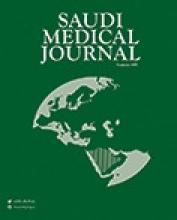Abstract
OBJECTIVE: To clarify the cardioprotective effects of a short course of vitamin E treatment (vit E) as compared with a nitric oxide donor, nitroglycerin (GTN) against ischemia-reperfusion induced heart injury in rats.
METHODS: This randomized control study was conducted in the Physiology Department, Faculty of Medicine, Ain Shams University, Cairo, Egypt from 1st June to 31 August 2009. This work was undertaken on 28 female Wistar rats weighing 150- 200 gm. Rats were allocated into 4 groups; control group (non-treated), GTN-treated group (rats received GTN intraperitoneally 25 minutes before sacrifice, in a dose of 120 ug/kg body weight), vit E-treated group (rat received vit E by oral tubal feeding 16-20 hours before sacrifice, in a dose of 250 mg/rat), and vit E and GTN-treated group (rats received vit E and GTN as in both GTN-treated group and vit E -treated group). After sacrifice, the hearts were excised and perfused in a Langendorff preparation and subjected to 30 minutes global ischemia and reperfused for 30 minutes. Following reperfusion, heart tissues were used for assessment of malondialdehyde (MDA) and nicotinamide adenine dinucleotide (NAD)+, and for histological examination.
RESULTS: Vitamin E treatment resulted in an enhanced post-ischemic recovery of systolic function in vit E-treated groups (vit E-treated group, and vit E and GTN-treated group) compared to the control group. Post-ischemic recovery of coronary flow was enhanced in the vit E-treated group compared to the GTN-treated group. Post ischemic tissue degeneration indicators: MDA, and NAD+ indicated a cardioprotective effect of vit E. Histological study revealed marked improvement of myocytes and mitochondrial structure in the vit E-treated group as compared with the control group.
CONCLUSION: Preconditioning with vit E treatment afforded substantial recovery of post-ischemic contractile, and vascular functions compared to GTN treatment, the mechanism might involve less opening of mitochondrial permeability transition during postischemic reperfusion.
- Copyright: © Saudi Medical Journal
This is an open-access article distributed under the terms of the Creative Commons Attribution-Noncommercial License (CC BY-NC), which permits unrestricted use, distribution, and reproduction in any medium, provided the original work is properly cited.






